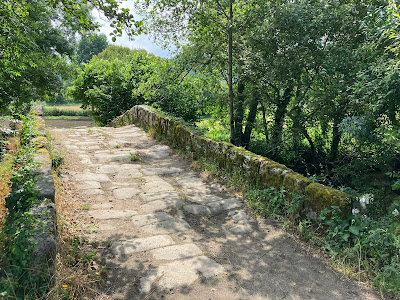Thomas, the hospitalero at the albergue two nights ago had recommended the Casa de Fernanda (a few kms before Vitorino dos Piães) where I stayed last night. It was remarkable.
We all slept in a bunkhouse separate from the family home. Beds with sheets, good shower.
Martin, a loud-voiced Dutchman and former security officer in a mental hospital, and on his sixth visit to the albergue, was playing the role of host when I arrived, plying us with wine and making sure that we knew each other. At one stage when he was making us go around a circle reciting everybody’s name from memory, I thought it prudent to disappear, but perhaps I should’ve stayed and practised in preparation for the big marbles test.
The evening meal was superb. We selected from a variety of dishes: sardines, which I declined, pork, rice, and various chick pea and bean plates.
(Sardines. Now that’s a Proustian moment. I recall the cans and feel the metal pressing into my finger as I twist the handle to open the can. And the taste, not of the fish themselves, but the heavy oil they were swimming in.)
After dinner, the host produced bottles of port and firewater, to prepare us for the singalong.
“Charles,” shouted Martin, from the other end of the table, as if I were one of his patients. “You sing.” I was ready to sing Waltzing Matilda, as I’ve had to do in the past when pilgrims were invited to sing a song from their own country, but fortunately, I held back, for it wasn’t that kind of singsong at all. There was actually a song book, but we certainly weren’t all singing from the same one, not the same tune, anyway.
The first song was one I realized I should have known, because everyone else did. “California Hotel”. It didn’t seem to have a tune, or not the way we sang it. And then we sang some Beatles songs, which I knew, of course, but it was difficult to know what key to sing them in. One fellow sang in a particular strident monotone with great enthusiasm. Sometimes Fernanda our hostess joined in with a voice like a wailing banshee. And you can imagine the cacophony when we sang “Hey Jude”. I made my excuses and retired early.
Breakfast was very good as well, with yoghurt, bread, cheese and sausage, and excellent coffee.
All of this for 25€. A couple of fellows who left early, gave me their money to pass on to the host. When I paid, he simply took the money without checking us of his list. I was moved by the trust we all had in each other.
It was a long day with some delightful moments and a serious climb.
As I entered the village of Vitorino dos Piães the clock in the church tower was striking nine very loudly, making sure that everyone was awake, first the quarters, then the hours, and then, in case someone had been woken up but not caught the time, it struck the hours again. Very sensible, that. After that, and a short, steep climb, I was hoping for a café at the top of the hill. But there wasn’t one. I chatted with an Aussie from Newcastle instead.
 |
|
A short stretch of highway and then off to the left, and an absolutely delightful walk along an old road, down and around the side of the valley, with lots of eucalyptus, of course, with its scent in the air, and broome and foxglove, and chirping birds, marred only by the snarl of a chainsaw in the woods, and the the sound and the fury of a two-stroke motorbike racing towards me, the curse of the Camino. As I ended the walk through the valley and entered the outskirts of Seara, I noticed an interesting statue of St. James in the wall. Rather aloof, I thought.
I shall refrain from returning to the theme of why I walk, but I was filled with euphoria as I strolled down this valley in the cool of the morning.
Ponte de Lima is a seaside resort on the river, the promenade lined with grand hotels and other magnificent buildings. You walk into town along an avenue of plane trees and approach the long, low, medieval stone bridge which has given the town its name. I will cross that bridge when I come to it, I thought.
 |
| The medieval bridge at Ponte de Lima |
I did, and I stopped for a small beer at a bar on the other side. Not a wise decision, for it was harder going afterwards.
I walked along the bank of the river, and came to another cobbled road. A woman was repositioning a stone, which, she said had been dislodged by a tractor. She confirmed that all the stones across Portugal had been laid by hand, originally just in sand but sometimes now in cement. They were historic and were being preserved.
I continued on past olive and walnut groves, and more and more grapevines. One farmer was spraying his vines, with a heavy, evil fog of pesticide. I hurried by.
In Vino Veritas
One day a fog came down upon the vine
And caught the budding insects in their prime.
While we, quite unaware, consume our wine
And stunted trees bear witness to the crime.
It was a bit of a bugger of a climb at the end, only 500-600 feet from bottom to top, but more than that because it was a series of ups and downs.
Finally, at 4:30 I reached Albergue O Conforto, which is not very comfortable and certainly not very hospitable. I have just eaten the worst dinner of my Camino life. But I’m the only person in a two-double-bunk room.
(Sorry about the formatting in this post. Blogger is driving me crazy)















